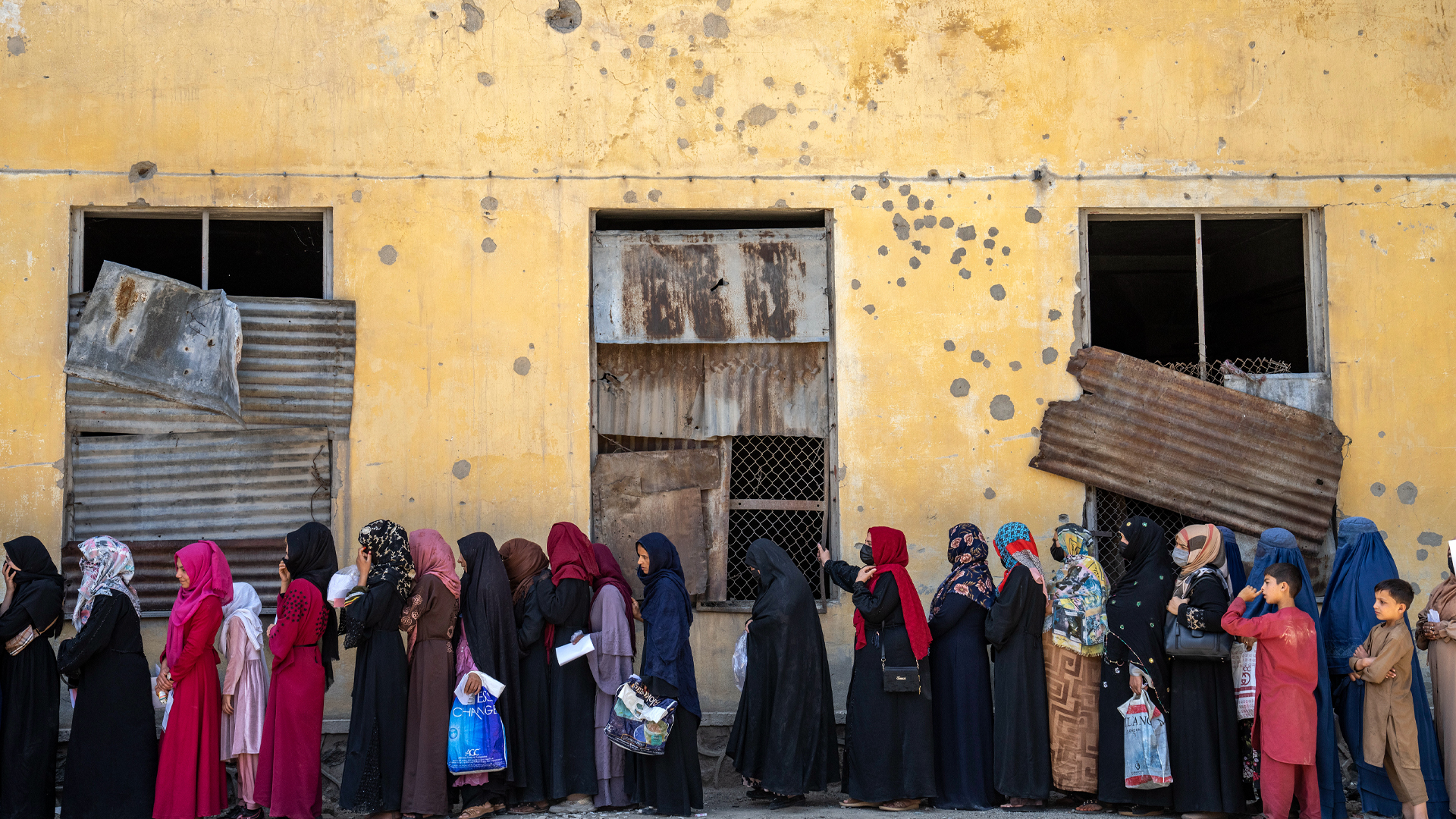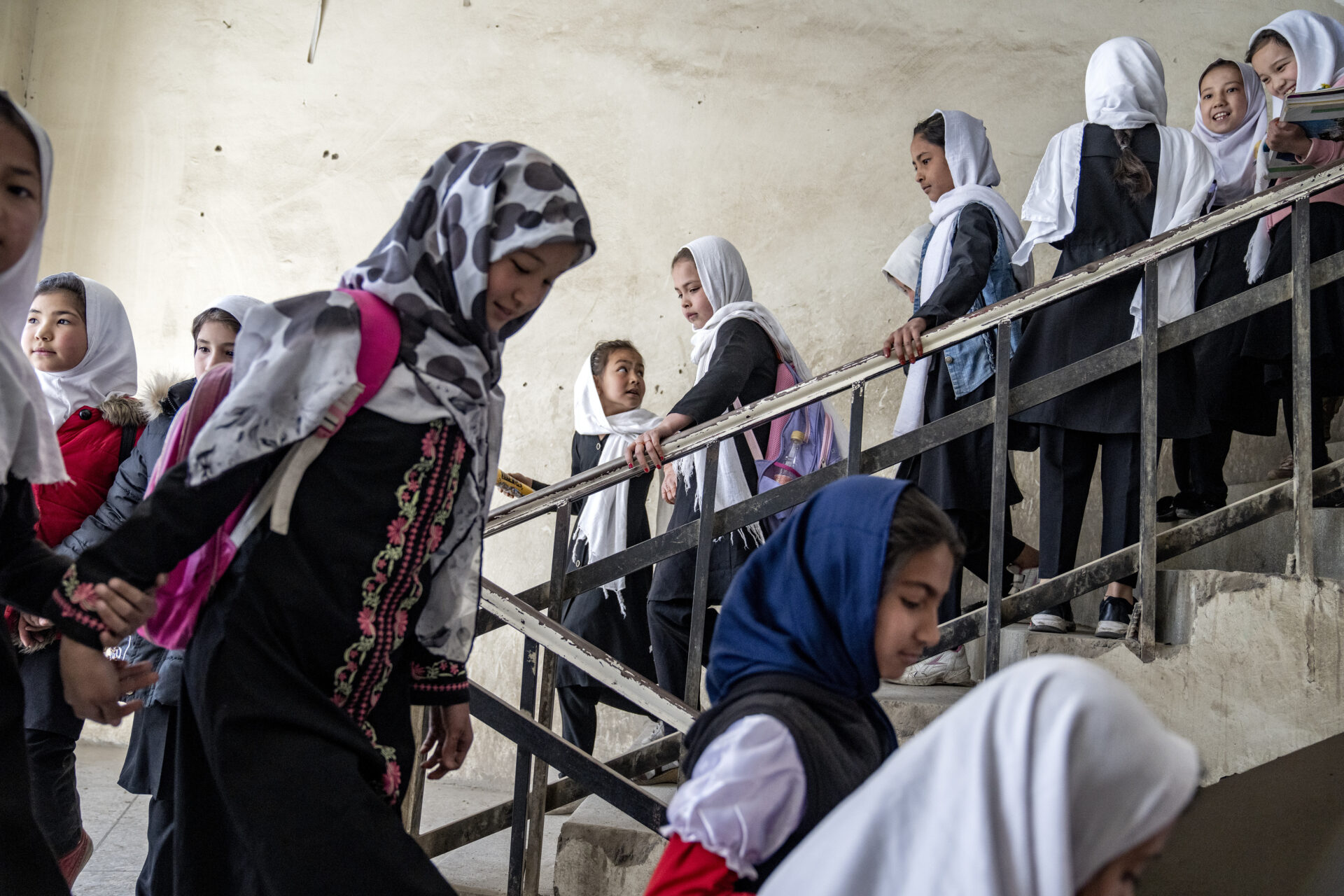Our protectionist dragnet keeps out highly qualified students in a bid to prevent potential asylum claimants from entering Canada. It makes no sense.

Afghan women wait to receive food rations distributed by a humanitarian aid group in Kabul, Afghanistan, May 2023. (AP Photo/Ebrahim Noroozi)
by Lisa Ruth Brunner
October 23, 2024
As the Taliban government in Afghanistan continues to tighten the vice on women’s rights – most recently by outlawing the sound of a woman’s voice outside her home – Canada is denying Afghan women the opportunity to pursue their academic dreams.
Recent examples include several women admitted to top Canadian universities yet refused study permits by the federal government.
Despite exceptional academic and leadership qualifications, prestigious scholarships and the support of local communities and legal immigration professionals, these decisions put post-secondary education out of reach for talented youth with few other options.
Of all the international students admitted to Canada, the small number of fully funded Afghan women should be among those prioritized. However, they face an uphill battle.
The Immigration and Refugee Protection Act stipulates that study permit applicants must prove they “will leave Canada by the end of the period authorized for their stay.” This is extremely difficult for Afghan women who likely qualify for asylum because they fear persecution in their home country.
In addition, their Afghan passport limits their ability to obtain legal entry into some other countries. Thus, no matter how exceptional the student or how generous the scholarship, proving not just their intention but even their ability to leave Canada once their studies are complete is easier said than done.
As a result, the study-permit approval rate for Afghans is extremely low. Yet other pathways to Canada are closed or exceptionally challenging.
As the Taliban government in Afghanistan continues to tighten the vice on women’s rights – most recently by outlawing the sound of a woman’s voice outside her home – Canada is denying Afghan women the opportunity to pursue their academic dreams.
Recent examples include several women admitted to top Canadian universities yet refused study permits by the federal government.
Despite exceptional academic and leadership qualifications, prestigious scholarships and the support of local communities and legal immigration professionals, these decisions put post-secondary education out of reach for talented youth with few other options.
Of all the international students admitted to Canada, the small number of fully funded Afghan women should be among those prioritized. However, they face an uphill battle.
The Immigration and Refugee Protection Act stipulates that study permit applicants must prove they “will leave Canada by the end of the period authorized for their stay.” This is extremely difficult for Afghan women who likely qualify for asylum because they fear persecution in their home country.
In addition, their Afghan passport limits their ability to obtain legal entry into some other countries. Thus, no matter how exceptional the student or how generous the scholarship, proving not just their intention but even their ability to leave Canada once their studies are complete is easier said than done.
As a result, the study-permit approval rate for Afghans is extremely low. Yet other pathways to Canada are closed or exceptionally challenging.
In Kabul, Afghanistan, girls attend school on the first day of the new school year in March 2023. (AP Photo/Ebrahim Noroozi, File)
Systemic double-standard
The irony is that Canada explicitly positions and uses its international student program to retain a significant proportion of graduates as workers and economic immigrants.
The federal government recognizes dual intent as legitimate, meaning study-permit applicants can intend to eventually apply for permanent residence. In certain cases, it is explicitly encouraged – as the recent francophone minority-communities student pilot demonstrates.
Even with the study-permit application cap recently introduced, Canada will continue to rely on international students as “a pool of talent for workers and/or permanent immigrants.”
If these Afghan students were granted permits to study in Canada, they would likely qualify for at least one economic provincial or federal government permanent residency pathway. For those admitted to highly ranked academic programs, particularly at the master’s and doctoral level, the odds are in their favour.
Yet in most cases, the barrier isn’t academic performance, funds or dual intent. The main hurdle these students face is simply obtaining the visa required to board a plane to Canada in the first place.
Border protection gone astray
Like many countries, Canada attempts to externalize its borders and as much as possible prevent the mere possibility that migrants will make asylum claims or attempt to stay beyond the validity of their permits.
As public attitudes toward the Liberal government’s immigration policies continue to sour, the government has been highlighting “bogus” asylum claims as a tactic to justify various immigration restrictions.
However, as a consequence many international students from countries with high levels of people trying to escape repressive conditions get caught in the same protectionist dragnet.
The result – the prevention of potential asylum claimants from stepping foot in Canada, no matter how valuable their contributions – is at odds with Canada’s humanitarian, economic and geopolitical goals.
It does not have to be this way.
The House of Commons special committee on Afghanistan drew a sharp contrast between Canada’s response to Afghanistan’s humanitarian crisis and the “swift and generous response to the displacement crisis generated by Russia’s war of aggression against Ukraine.”
The incoherence of Canada’s refugee policy
Afghanistan, “graveyard of empires,” was once beautiful, vibrant and safe
The Canada-Ukraine authorization for emergency travel used temporary residence as a flexible pathway toward more long-term protection. While this measure was not without its challenges, it demonstrated the potential for accommodation when Immigration, Refugees and Citizenship Canada assesses a temporary resident’s intent to leave Canada.
In response to the committee’s suggestion to allow “Afghans to access study permits, including individuals who have obtained full scholarships or are continuing their studies…without assessing the intention of returning to their country of origin,” the government committed to actively explore the recommendation and consider options to enable Afghans to study in Canada.
That was in 2022. Nearly three years later, the refusals continue.
Opening doors
One option is to amend the Immigration and Refugee Protection Act to better reflect the realities of multi-step immigration today.
Another is to build upon lessons learned from what are known as “complementary education pathways.” For example, the World University Service of Canada student refugee program successfully uses Canada’s private sponsorship of refugees to resettle displaced post-secondary students through a youth-to-youth model.
Since 1978, a small number of highly qualified displaced students have made long-term economic contributions to Canada and played leadership roles in their home countries’ future development.
Higher education is a key area of disparity among displaced populations. Only seven per cent of refugees access higher education compared to a global average of 42 per cent. Young women and girls are especially excluded.
The United Nations High Commissioner for Refugees now encourages the development of more complementary education pathways to help students seeking protection in third countries.
The Global Task Force on Third Country Education Pathways is working to expand such measures and the United States recently launched its welcome corps on campus program.
Complementary education pathways can come in many forms and are an obvious win. They not only provide opportunities for education and skills training, but also offer safe haven.
Canada should honour its stated commitments and live up to its international brand. This can be achieved by developing study-permit approval structures for displaced international students during future urgent crises.
More importantly, as Canada rethinks the structure and purpose of both its international student program and international education strategy, it should explore new, sustainable and innovative complementary education pathways that enable international students who are facing injustices unimaginable to most of us to build a brighter future.

Lisa Ruth Brunner
Lisa Ruth Brunner is a postdoctoral research fellow at the University of British Columbia Centre for Migration Studies; a public-policy consultant with the Affiliation of Multicultural Societies and Service Agencies of BC; and a regulated Canadian immigration consultant.View all by this author
You are welcome to republish this Policy Options article online or in print periodicals, under a Creative Commons/No Derivatives licence.

No comments:
Post a Comment